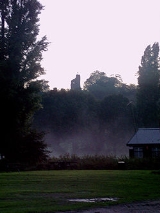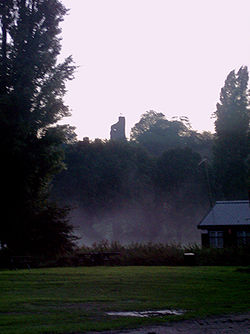
Tutbury
Encyclopedia
Tutbury is a large village
and civil parish of about 3,000 residents in the English
county of Staffordshire
.
It is surrounded by the agricultural countryside of both Staffordshire and Derbyshire
. The site has been inhabited for over 3000 years, with Iron Age defensive ditches encircling the main defensive hill, upon which now stands ruins of a Norman castle. These ditches can be seen most clearly at The Park pale and at the top of the steep hills behind Park Lane.
 The name Tutbury probably derives from a Scandinavian settler and subsequent chief of the hill-fort, Totta, bury being a corruption of burh the Anglo-Saxon name for 'fortified place'.
The name Tutbury probably derives from a Scandinavian settler and subsequent chief of the hill-fort, Totta, bury being a corruption of burh the Anglo-Saxon name for 'fortified place'.
It is 5 miles north of Burton upon Trent
and 20 miles south of the Peak District
.
Quarries near Tutbury once produced alabaster
which was used in the carving of Nottingham Alabaster
.
Until 2006, Tutbury Crystal, a manufacturer of high-quality cut glass products, was based in the village--however production transferred to Stoke-on-Trent
as the existing factory was very old and was thought to be too small for the modern company's requirements. The old factory was demolished and apartments are built on the site, but a factory shop still operates in the village however. Despite this, the tourism trade survives thanks to the long and distinguished history of the Norman Priory Church and medieval Tutbury Castle
where Mary, Queen of Scots, was once imprisoned.
Tutbury Castle
became the headquarters of Henry de Ferrers
and was the centre of the wapentake of Appletree, which included Duffield Frith
. With his wife Bertha, he endowed Tutbury Priory with two manors in about 1080. It would seem that Tutbury at that time was a dependency of the Norman
abbey of St Pierre‑sur‑Dives. One of the Royal Studs was established in the area round the castle by Henry VIII but had to be abandoned after the Civil War.
Until the 18th century, Tutbury was the site of an annual court of minstrel
s. There was even a "King of the Minstrels".
There are some fine Georgian
and Regency
buildings and the half-timbered Dog and Partridge Hotel. There are antique and craft shops in the village some of which have been run by the same families for many years.
Tutbury and Hatton railway station
, was opened by the North Staffordshire Railway
on 11 September 1848. It then closed during the 1960s to reopen in 1989. It is on the Crewe to Derby Line
.
spin-off series Most Haunted: Midsummer Murders
where the team investigated a murder over hidden treasure.
Village
A village is a clustered human settlement or community, larger than a hamlet with the population ranging from a few hundred to a few thousand , Though often located in rural areas, the term urban village is also applied to certain urban neighbourhoods, such as the West Village in Manhattan, New...
and civil parish of about 3,000 residents in the English
England
England is a country that is part of the United Kingdom. It shares land borders with Scotland to the north and Wales to the west; the Irish Sea is to the north west, the Celtic Sea to the south west, with the North Sea to the east and the English Channel to the south separating it from continental...
county of Staffordshire
Staffordshire
Staffordshire is a landlocked county in the West Midlands region of England. For Eurostat purposes, the county is a NUTS 3 region and is one of four counties or unitary districts that comprise the "Shropshire and Staffordshire" NUTS 2 region. Part of the National Forest lies within its borders...
.
It is surrounded by the agricultural countryside of both Staffordshire and Derbyshire
Derbyshire
Derbyshire is a county in the East Midlands of England. A substantial portion of the Peak District National Park lies within Derbyshire. The northern part of Derbyshire overlaps with the Pennines, a famous chain of hills and mountains. The county contains within its boundary of approx...
. The site has been inhabited for over 3000 years, with Iron Age defensive ditches encircling the main defensive hill, upon which now stands ruins of a Norman castle. These ditches can be seen most clearly at The Park pale and at the top of the steep hills behind Park Lane.

It is 5 miles north of Burton upon Trent
Burton upon Trent
Burton upon Trent, also known as Burton-on-Trent or simply Burton, is a town straddling the River Trent in the east of Staffordshire, England. Its associated adjective is "Burtonian"....
and 20 miles south of the Peak District
Peak District
The Peak District is an upland area in central and northern England, lying mainly in northern Derbyshire, but also covering parts of Cheshire, Greater Manchester, Staffordshire, and South and West Yorkshire....
.
Quarries near Tutbury once produced alabaster
Alabaster
Alabaster is a name applied to varieties of two distinct minerals, when used as a material: gypsum and calcite . The former is the alabaster of the present day; generally, the latter is the alabaster of the ancients...
which was used in the carving of Nottingham Alabaster
Nottingham Alabaster
Nottingham alabaster is a term used to refer to the English sculpture industry, mostly of relatively small religious carvings, which flourished from the fourteenth century until the early sixteenth century...
.
Until 2006, Tutbury Crystal, a manufacturer of high-quality cut glass products, was based in the village--however production transferred to Stoke-on-Trent
Stoke-on-Trent
Stoke-on-Trent , also called The Potteries is a city in Staffordshire, England, which forms a linear conurbation almost 12 miles long, with an area of . Together with the Borough of Newcastle-under-Lyme Stoke forms The Potteries Urban Area...
as the existing factory was very old and was thought to be too small for the modern company's requirements. The old factory was demolished and apartments are built on the site, but a factory shop still operates in the village however. Despite this, the tourism trade survives thanks to the long and distinguished history of the Norman Priory Church and medieval Tutbury Castle
Tutbury Castle
Tutbury Castle is a largely ruinous medieval castle at Tutbury, Staffordshire, England, in the ownership of the Duchy of Lancaster. It is a Grade I listed building...
where Mary, Queen of Scots, was once imprisoned.
Tutbury Castle
Tutbury Castle
Tutbury Castle is a largely ruinous medieval castle at Tutbury, Staffordshire, England, in the ownership of the Duchy of Lancaster. It is a Grade I listed building...
became the headquarters of Henry de Ferrers
Henry de Ferrers
Henry de Ferrers was a Norman soldier from a noble family who took part in the conquest of England and is believed to have fought at the Battle of Hastings of 1066 and, in consequence, was rewarded with much land in the subdued nation.His elder brother William fell in the battle. William and Henri...
and was the centre of the wapentake of Appletree, which included Duffield Frith
Duffield Frith
Duffield Frith was, in medieval times, an area of Derbyshire in England, part of that bestowed upon Henry de Ferrers by King William, controlled from his seat at Duffield Castle. From 1266 it became part of the Duchy of Lancaster and from 1285 it was a Royal Forest with its own Forest Courts.It...
. With his wife Bertha, he endowed Tutbury Priory with two manors in about 1080. It would seem that Tutbury at that time was a dependency of the Norman
Normans
The Normans were the people who gave their name to Normandy, a region in northern France. They were descended from Norse Viking conquerors of the territory and the native population of Frankish and Gallo-Roman stock...
abbey of St Pierre‑sur‑Dives. One of the Royal Studs was established in the area round the castle by Henry VIII but had to be abandoned after the Civil War.
Until the 18th century, Tutbury was the site of an annual court of minstrel
Minstrel
A minstrel was a medieval European bard who performed songs whose lyrics told stories of distant places or of existing or imaginary historical events. Although minstrels created their own tales, often they would memorize and embellish the works of others. Frequently they were retained by royalty...
s. There was even a "King of the Minstrels".
There are some fine Georgian
Georgian architecture
Georgian architecture is the name given in most English-speaking countries to the set of architectural styles current between 1720 and 1840. It is eponymous for the first four British monarchs of the House of Hanover—George I of Great Britain, George II of Great Britain, George III of the United...
and Regency
English Regency
The Regency era in the United Kingdom is the period between 1811—when King George III was deemed unfit to rule and his son, the Prince of Wales, ruled as his proxy as Prince Regent—and 1820, when the Prince Regent became George IV on the death of his father....
buildings and the half-timbered Dog and Partridge Hotel. There are antique and craft shops in the village some of which have been run by the same families for many years.
Tutbury and Hatton railway station
Tutbury and Hatton railway station
Tutbury and Hatton Station is a railway station on the Crewe-Derby Line. The station is served by trains on the Crewe to Derby Line which is also a Community rail line known as the North Staffordshire line...
, was opened by the North Staffordshire Railway
North Staffordshire Railway
The North Staffordshire Railway was a British railway company formed in 1845 to promote a number of lines in the Staffordshire Potteries and surrounding areas in Staffordshire, Cheshire, Derbyshire and Shropshire....
on 11 September 1848. It then closed during the 1960s to reopen in 1989. It is on the Crewe to Derby Line
Crewe to Derby Line
The Crewe to Derby Line is a railway line in central England, running from Crewe south east to Derby. Services on the line are provided by East Midlands Trains....
.
On Television
The village of Tutbury was featured in the Most HauntedMost Haunted
Most Haunted is a British paranormal documentary reality television series. The series was first shown on 25 May 2002 and ended on 21 July 2010. It was broadcast on Living and presented by Yvette Fielding. The programme was based on investigating purported paranormal activity...
spin-off series Most Haunted: Midsummer Murders
Most Haunted: Midsummer Murders
Most Haunted: Midsummer Murders is a spin-off series of the paranormal television series, Most Haunted. It ran on LivingTV between 19 June 2007 and 7 August 2007.- Idea :...
where the team investigated a murder over hidden treasure.

